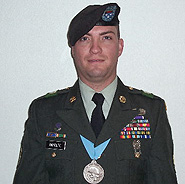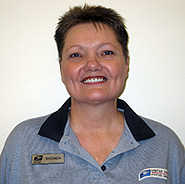Army to Award Bronze Star To APWU Members’ Son
May 29, 2009
 Kevin Imholte, son of Minneapolis Area Local APWU activists Brenda and Vern Wellman, will be awarded the Bronze Star Medal for an act of bravery in Iraq two years ago.
Kevin Imholte, son of Minneapolis Area Local APWU activists Brenda and Vern Wellman, will be awarded the Bronze Star Medal for an act of bravery in Iraq two years ago.
Staff Sgt. Imholte was a squad leader for an Army unit whose mission on the evening of May 30, 2007, was to establish an “overwatch position” on a road notorious for the emplacement of improvised explosive devices (IEDs).
According to the U.S. Army account of the incident, the squad was moving into position when it came under heavy enemy fire, requiring Sgt. Imholte to “low-crawl to a slightly covered position. This position consisted of a raised concrete curb, which could hardly be described as any type of cover. From there, Sgt. Imholte rapidly fired 30 rounds from his M4 into the crew-served position… quelling this insurgent’s fire.” He subsequently facilitated the successful safe transfer from the area of two wounded members of his squad.

Brenda Wellman is a clerk and APWU steward in the Elk River Associate Office. Her husband, fellow APWU member Vern Wellman, is a Driver Safety Instructor in Minneapolis.
Son Kevin is currently stationed in Colorado but is scheduled for deployment to Afghanistan early this summer. This will be his fourth overseas assignment – in addition to two stints in Iraq, he has served in Kosovo.
U.S. Army account
On the night of 30 MAY 2007, SSG (Staff Sergeant) Imholte was the lead soldier in a squad file; this was part of a small kill team consisting of 6 men. This was a platoon mission that consisted of two dismounted elements, one being SSG Imholte’s. His squad’s mission was to establish an overwatch position on a road that was notorious for emplacement of improvised explosive devices; this road was in the most contested muhalla in the 2-12th Infantry Battalion’s area of operations. As the squad was moving into position 70 meters past the muhalla’s perimeter road, the element took a barrage of fire from both crew served weapons and assorted small arms. On contact, SSG Imholte low crawled into enemy fire to a slightly covered position. This position consisted of a raised concrete curb, which could hardly be described as any type of cover. From there, SSG Imholte rapidly fired thirty rounds from his M4 into the crew served position which was 25 meters to his front, quelling this insurgent’s fire.
Unbeknownst to SSG Imholte, the other soldiers to his rear, his Platoon Leader — 1LT (First Lieutenant) Stone and automatic rifleman – PFC (Private First Class) Baylis, had sustained multiple wounds to their lower bodies. When SSG Imholte reloaded his weapon to further suppress the enemy crew-serve position, he looked back to notice the automatic rifleman was on the ground screaming for his life. Immediately, SSG Imholte crawled back to this soldier. The insurgent then directed his fire towards both of these soldiers, so SSG Imholte fired 100 rounds from PFC Baylis’ squad automatic weapon onto the enemy’s position. All the while, he was still receiving effective small arms fire from three rooftops. When SSG Imholte yelled for help, he heard no response; he was not able to locate any of his fellow squad members. In order to gain a response from his squad, he pulled out his radio to call for help, but the radio was shot out of his hand. SSG Imholte was alone, outgunned, outmanned, and with a wounded soldier. So, without regard for his own life he began carrying this soldier to safety. In the process of carrying this soldier to safety, the already wounded soldier now became severely wounded by sustaining a gunshot wound to his neck. This soldier’s wound forced them both to drop to the ground. At that point, SSG Imholte knew the only way to get out alive was to drag this warrior away from fire to where his squad could potentially be. Because the crew-served position was now becoming so accurate on the two slow-moving soldiers, SSG Imholte feared his buddy would suffer even more gunshot wounds, so he stopped multiple times. Whenever SSG Imholte stopped, he cared not for his own life, but for PFC Baylis’ life. SSG Imholte used his own body as a shield, while returning a rapid rate of fire into the enemy’s nest. Since SSG Imholte was still yelling for help, he finally got a response from the RTO (radio telephone operator) who had rallied with the others into a local courtyard on the outside of a house. At this time, the RTO and SSG Imholte both continued to drag the wounded warrior to cover.
This courtyard, which was only 20 meters away from the enemy fire, now became a hasty casualty-collection point. At this collection point, SSG Imholte was under extreme duress but still managed to assess the situation. As a true leader, he knew he had to secure the area and suppress the enemy before the casualties could be cared for. Therefore, he directed two other soldiers, one being a team leader, to take the wounded soldier’s Squad Automatic Weapon onto the rooftop. This action was to suppress the enemy fire that remained an imminent threat. Then SSG Imholte ordered the RTO to conduct buddy aid on the wounded soldier he had drug into the courtyard. While the RTO was treating the wounded soldier, SSG Imholte did a quick head count and realized he was still missing his Platoon Leader. He yelled over-fire to determine the whereabouts of his Platoon Leader and his RTO said he was in a nearby room. SSG Imholte ran to the room to find his Platoon Leader on the ground with a gunshot wound to the leg. Imholte exposed the Platoon Leader’s wound, placed a tourniquet on it, and consolidated both casualties at the back of the courtyard. After the casualties were consolidated, SSG Imholte radioed the other element for further medical support. When the medic and his crew approached, SSG Imholte stepped out of the courtyard into a defilade of fire. At no point during this engagement did SSG Imholte care about his own life; instead, SSG Imholte solely wanted to save the lives of his comrades.
Once the medic and his crew arrived into the courtyard, SSG Imholte gave a concise explanation of the current situation. He then continued to direct the new soldiers and medic as to what they should do. Imholte sent two more soldiers onto the rooftop to concentrate their fires on the crew-served weapon position. SSG Imholte remained with the casualties and the medic and radioed for a quick reaction force (QRF). Over the radio, SSG Imholte had to instruct this QRF how to best maneuver their vehicles in order to properly provide cover for the casualty evacuation. But since the vehicles could not maneuver closer than 100 meters to the casualties, SSG Imholte created an ad-hoc team to take LT Stone to the vehicles through heavy, pinpoint, enemy fire. The Platoon medic continued to stabilize PFC Baylis. Once PFC Baylis was stable enough to be taken to the vehicles, SSG Imholte had two teams provide security for the transport team. He directed these teams to travel 20 meters behind the casualty in order to provide rear security. This was done because the transport team had to stop every five meters to reposition the casualty while still taking heavy, effective direct fire. This direct-fire engagement did not cease until all soldiers were out of the muhalla.
SSG Imholte’s exceptional leadership is the epitome of how a Non-Commissioned Officer should act in a combat situation. His dedication to duty ensured that no further casualties were inflicted upon the platoon that night. SSG Imholte's courage under fire reflect great credit upon himself, his unit Chosen Company, 2nd Battalion, 12th Infantry Regiment, and his country. "WARRIORS!"



